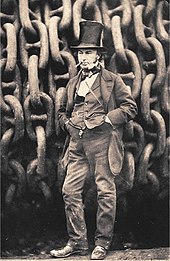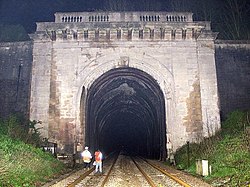Box tunnel
| Box tunnel | ||
|---|---|---|
|
West portal
|
||
| Official name | Box tunnel | |
| use | Railway tunnel | |
| traffic connection | London – Bristol railway line | |
| place | Box (wiltshire) | |
| length | 2950 meters (1.83 miles) | |
| Number of tubes | 1 | |
| construction | ||
| Client | Great Western Railway | |
| start of building | 1836 | |
| completion | 1841 | |
| planner | Isambard Kingdom Brunel | |
| business | ||
| release | June 30, 1841 | |
| location | ||
|
|
||
| Coordinates | ||
| East portal | 51 ° 25 ′ 25 ″ N , 2 ° 12 ′ 19 ″ W. | |
| West portal | 51 ° 25 ′ 8 " N , 2 ° 14 ′ 49" W. | |

The Box Tunnel is a 2.9 km long railway tunnel from the early days of railroad history on the London – Bristol line between Chippenham and Bath , near the town of Box , at times also Box Hill , with a kilometer between 99 stat.mi. 12 ch and 100 stat.mi. 78 ch.
construction
The tunnel was designed and built by Isambard Kingdom Brunel . He is said to have had the tunnel constructed in such a way that the sun shines through the entire tunnel on April 9, his birthday; however, this thesis is controversial. The tunnel has four ventilation shafts and has a gradient of one percent from east to west.
Brunel carried out eight exploratory wells in 1836 and 1837 to examine the quality of the rock. The actual construction work began in December 1838 in six separate areas: at the two tunnel portals and at the foot of the four future ventilation shafts. The workers, the building materials and the overburden totaling 189,000 m³ were lifted up and down the shafts with steam-powered winches and horse power.
The length of the tunnel met with both technical and operational concerns. As with the construction of shipping canals, the western part of the tunnel was dug with a pick and shovel and then lined with bricks. The eastern part of the tunnel was blasted out with black powder.
The tunnel had to be hewn out of the rock, as dynamite , which was used in the large tunnels at the end of the 19th century, was not yet available. Operational concerns arose because of the exhaust fumes from the steam locomotives as well as medical concerns about the safety for passengers: Critical voices feared that the passengers in the tunnel would become deaf.
The work was carried out around the clock in several shifts. Initially 1,500 workers and over 100 horses were employed, this number increased to 4,000 workers and 300 horses in the last six months before the tunnel was completed. The construction work proved difficult. Problems arose right from the start because the construction site was flooded. The tunnel construction took a total of five years and almost 100 workers were killed. When the two tunneling sections met, the deviation was only 5 cm. The work was finished in the spring of 1841 and on June 30, 1841 the railway line was opened. At that time, the Box Tunnel was the longest railway tunnel in the world.
On the west side of the tunnel in the Box area, there is a monumental portal at the entrance, while the eastern opening of the tunnel at Corsham is kept simpler.
Quarry
A profitable side effect of the tunnel construction was the development of large deposits of yellow oolithic limestone ( bath stone ) from the Jura , which was highly suitable for construction. Huge underground quarries were dug between Box Hill and Corsham, branching off from the tunnel. From there the stones were transported with carts from the quarries to the tunnel and with a narrow-gauge railway along the railway line in the tunnel. At the end of the tunnel at Corsham there was and is a separate exit for this train. With the possibility of transporting the stones by rail, a large number of cities and thus a large market could be reached. For example, some colleges at Oxford University were built with stones from box. The quarrying industry peaked between 1880 and 1909 when millions of tons of limestone were sold. The quarries remained open until 1969.
Military use
The caves created by stone quarrying were used during World War II to store ammunition and to house a factory for aircraft engines. The underground quarries below Hartham Park alone cover an area of 8 square miles (approx. 20.72 km²) in which the Royal Navy was stationed; Part of it has been used as a quarry by a British subsidiary of HeidelbergCement AG since May 2010 . A message center was also set up here, which was connected by shafts to an air force base above. To serve these facilities, an underground station with two platforms was built. During the Cold War , the facility was made safe from nuclear bombs . Easily accessible from London, it was intended as a command center and shelter for the government and the royal family in the event of a nuclear war ( Central Government War Headquarters ). In the cave system there are still military facilities, albeit reduced in size.
literature
- Mike Bridge (Ed.): Track Atlas of Mainland Britain . Bradford on Avon 2009.
- R. Buchanan, R. Angus: Brunel: The Life and Times of Isambard Kingdom Brunel . Hambledon / London 2002, ISBN 1-85285-331-X
- Maurice Chittenden: For sale: Britain's underground city. In: Times Online. October 30, 2005, accessed May 18, 2007.
- Richard Deiss: Vane Cathedral and Sugar Beet Station. A short story about 200 European train stations . Bonn 2010, p. 61.
- Peter Hennessy: The Secret State - Whitehall and the Cold War . 2005, ISBN 0-14-100835-0
- Rory Lushman: The Box Hill Tunnel: An Anorak's Paradise or a Passage To Narnia? 1999. Retrieved May 18, 2007.
- Nick McCamley: Secret Underground City . Pen & Sword Books, 2002, ISBN 0-85052-733-3
Web links
- Subterranea Britannica Entrance to the Corsham Bunker
- Brunel portal
- Wiltshire's Secret Underground City: Burlington article, interactive map and video from BBC Wiltshire
Individual evidence
- ↑ Deiss.
- ↑ http://www.engineering-timelines.com/scripts/engineeringItem.asp?id=38
- ↑ Deiss, p. 61.
- ↑ heidelbergcement.com : Bath stone , in English, accessed on May 8, 2011
- ↑ heidelbergcement.com : Box Ground Bathstone back into production for first time in 60 years , in English, accessed on May 8, 2011
- ↑ Deiss.


